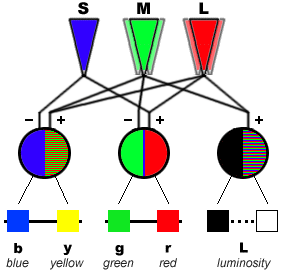Sensation: your window to the world
Perception: interpreting what comes in your window
SENSATION: the process by which our sensory receptors and nervous system receive stimulus from the environment.
Concepts....
1. Bottom-up Processing: begins with the sense receptors and works up to the brain's integration of sensory information.
Absolute Threshold: the minimum stimulation needed to detect a stimulation needed to detect a stimulus 50% of the time.
Difference Threshold: the minimum difference that a person can detect between two stimuli.
Weber's Law: the idea that, to perceive a difference between two stimuli, they must differ by a constant percentage, not a constant.
Signal Detection Theory: predicts how we detect a stimulus amid other stimuli.
Sensory Adaptation: decreased responsiveness to stimuli due to constant stimulation
Selective Attention: the focusing of conscious awareness on a particular stimulus.
Cocktail Party Phenomenon: cocktail party effect describes the ability to focus on ones listening attention on a single talker among a mixture of conversations and background noises... Ignoring other conversations.
Energy Vs. Chemical Senses:
Vision: our most dominating sense.
- The height of a wave gives us intensity (brightness)
- The length of the wave gives us its hue (color)
- ROY G BIV
- The longer the wave, the more red it is.
- The shorter the wavelength, the more violet.
Young-Helmholtz Theory:
Three types of cones...
- Red
- Blue
- Green
Opponent Process Theory: sensory receptors come in pairs.
- Red and Green
- Blue and Yellow
- Black and White
If one color is stimulated, the other color in inhibited.
Sound
Important words when it comes to sound....
Amplitude and Wavelength
-The height of the wave gives us the amplitude.
-The longer the wavelength, the lower the pitch and vice versa.
-Sound waves hit the eardrum, then the anvil, then the hammer, then the stirrup, then the oval window.
-The cochlea is lined with mucus called basilar membrane.
-In the basilar membrane, there are hair cells.
-When hair vibrates, the vibrations turn into neural impulses which are called Organ of Corti.
-Sent to thalamus up auditory nerve.
- Place Theory: different hairs vibrate in the cochlea when there are different pitches, so some hairs vibrate when they hear high pitches.
- Frequency Theory: all the hairs vibrate at different speed.
Deafness
- Conduction Deafness: something goes wrong with the sound and the vibration is on its way to the cochlea.
- Nerve (sensorineural) Deafness: hair cells in cochlea get damaged.
Causes of deafness...
- loud noise
- no way to replace hairs
- cochlea implant is possible
Why do we study smell and taste together??????
Sensory Interaction: the principle that one sense may influence another.
-We have bumps on our tongue called papillae.
-Taste buds are located on the papille (all over the mouth actually)
(picture of sweet salty bitter blah blah blah)
- receptors located in our skin.
Vestibular Sense: tells us where our body is oriented in space
-Our sense of balance
Kinestetic Sense: tells us where our body parts are
-Receptors located in our muscles and joints
PERCEPTION: The process of organizing and interpreting information, enabling us to recognize meaningful objects and events.
Gestalt Philosophy: the whole is greater than the sums of its parts.
Figure Ground Relationship: the organization of the visual field into objects (figures) that stand out from their surroundings.
Grouping: the perceptual tendency to organize stimuli into groups that we undersand.
- Proximity:
- Similarity:
- Continuity:
- Connectedness:
- Allows us to judge distance
Binocular Cues
Retinal Disparity: a binocular cue for seeing depth. The closer an object comes to you, the greater the disparity is between the two images.









I like the visuals, they help me better understand the differences in the theories.
ReplyDelete